Contents:
Common Names | Parts Usually Used | Plant(s) & Culture | Where Found | Medicinal Properties
Legends, Myths and Stories | Uses | Formulas or Dosages | How Sold | Warning | Resource Links | Bibliography
Scientific Names
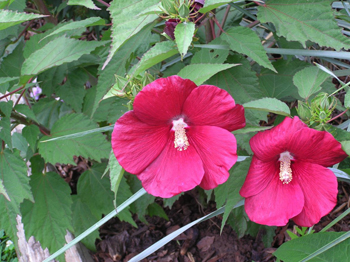
- Hibiscus moscheutos L.
- Hibiscus abelmoschus L.
- Hibiscus sabdariffa L.
- Hibiscus Sandariffa L.
- Hibiscus rosa-sinensis L.
- Hibiscus palustris L.
- Hibiscus tiliaceus L.
- Hibiscus trionum L.
- Malvaceae
- Mallow family
Common Names
Hibiscus moscheutos L.:
- Swamp rose-mallow
Hibiscus abelmoschus L.:
- Musk-mallow
- Musk seed plant
- Rose mallow
- Syrian mallow
- Target-leaved hibiscus
- Water mallow
Hibiscus sabdariffa L.:
- Guinea sorrel
- Jamaica sorrel
- Reselle
Hibiscus Sandariffa var. roselle L.:
- Jamaica sorrel
Hibiscus rosa-sinensis L.:
- Rose of China
- Chinese hibiscus
Hibiscus palustris L.:
- Marsh hibiscus
Hibiscus tiliaceus L.:
- Corkwood
- Cuban bast
- Mahoe
Hibiscus trionum L.:
- Flower-of-an-hour
- Venice mallow
Parts Usually Used
Hibiscus moscheutos L.:
Leaves and root
Back to Top
Description of Plant(s) and Culture
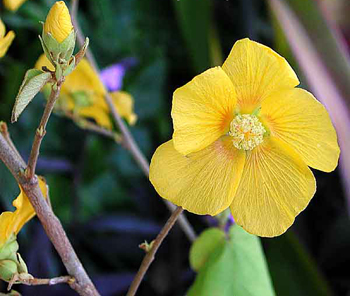
The name Hibiscus refers actually to a genus including about 200 species of plants, a number of which have medicinal uses. The hibiscus best known for medicinal properties is Musk-Mallow.
Hibiscus abelmoschus L.:
Musk-mallow is an annual or biennial plant; the stem, growing from 2-6 feet high, bears alternate leaves which are usually sharply lobed and irregularly toothed but sometimes only shallowly lobed and like maple leaves. Both sides are thinly hairy. The large, axillary flowers are yellow and have red centers. An oblong, pointed, hairy capsule up to 3 inches long contains the kidney-shaped, grayish-brown musk-odored seeds.
Hibiscus moscheutos L.:
Musky scented perennial; 5-7 feet high. Lower leaves often 3-lobed; median leaves lance-shaped. Flowers to 8 inches across; white, with a purple-red center; June to September. Sometimes called mallow rose and wild cotton.
Hibiscus bancrostianusL.:
An herbaceous plant of the West Indies which is used like althea.
Hibiscus esculentus L.:
Found in tropics of the Old World. Both roots and fruit are used as demulcents, the leaves as emollient poultices. Known as okra or gumbo.
Hibiscus palustris L.:
Marsh hibiscus, found in the swamps of the eastern United States. Used like althea.
Hibiscus rosa-sinensis L.:
Rose of China, Chinese hibiscus. Grown mostly for ornament, this shrub or small tree also has astringent and demulcent properties.
Hibiscus sabdariffa L.:
Guinea sorrel, Jamaica sorrel, reselle; a tall annual plant found in the tropics of the Old World. The herb is useful as a diuretic and refrigerant.
Hibiscus Sandariffa var. roselle L.:
Also called Jamaican sorrel, is a strong grower whose calyx is harvested for use in sauces and jellies.
Hibiscus sagittifolius L.:
A perennial herb found in Indochina. The root is said to be highly effective against excessive mucous discharge (blenorrhagia).
Hibiscus Surattensis L.:
A trailing shrub found in the tropical countries of Asia and Africa. It is used to soothe coughs and as an emollient.
Hibiscus tiliaceus L.:
Corkwood, Cuban bast, mahoe; A shrub or tree found in tropical countries. The inner bark has mucilaginous and emollient properties.
Hibiscus trionum L.:
Flower-of-an-hour, Venice mallow; originally from central Africa, now found as a weed in North America. The plant has mucilaginous and emollient properties.
Back to Top
Where Found
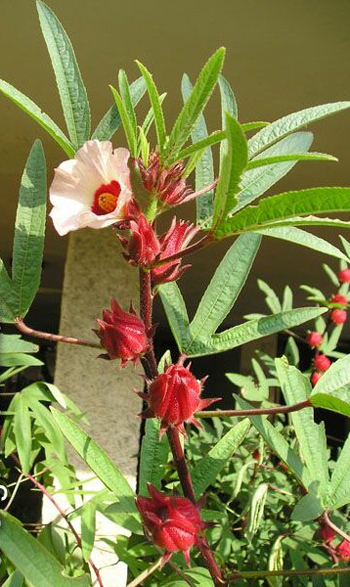
Hibiscus abelmoschus L.:
Grows wild in Egypt, India, and the East and West Indies; it is also cultivated elsewhere.
Hibiscus moscheutos L.:
Marshes. Maryland to Florida; Alabama to Indiana.
Back to Top
Medicinal Properties
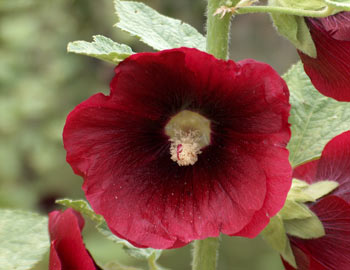
Hibiscus abelmoschus L.:
Antispasmodic, nervine, stomachic.
Back to Top
Legends, Myths and Stories
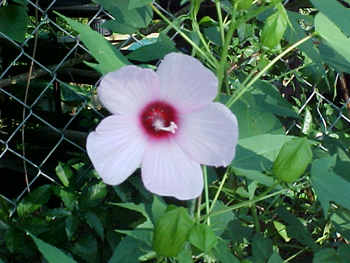
In herb and spice shops hibiscus is sold under the name of Nubia flowers, red mallow, African mallow, carcade, or roselle; all these terms refer to hibiscus flowers. These are the dried calyxes and outer calyxes, harvested during fruiting season, of H. sabdariffa L. A shrubby member of the mallow family that is probably native to Africa but grows also in China, Mexico, Thailand, and the Sudan. Slightly tart taste. The flowers do markedly improve the taste of all tea blends to which they are added.
Back to Top
Uses
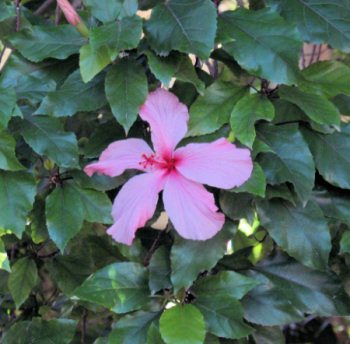
Hibiscus abelmoschus L.:
An emulsion made from the seeds is said to be useful for spasmodic problems. An emulsion mad with milk can be used for itchy skin. In Egypt, the seeds are chewed to relieve stomach problems, to soothe the nerves, and to “sweeten” the breath. Egyptians also consider the seeds to have aphrodisiac powers.
Hibiscus moscheutos L.:
Abounds in mucilage. Leaves and roots of this plant, like those of related species and genera, used as demulcent and emollient in dysentery and lung and urinary ailments.
Hibiscus rosa-sinensis L.:
Rose of China, Chinese hibiscus. Grown mostly for ornament, this shrub or small tree also has astringent and demulcent properties. A decoction of roots is used as an eyewash in Malaya; the bark is used in Asia as an emmenagogue (encourages menstrual flow); the flowers are said to be astringent. The flowers are usually used for fevers and minor stomach and intestinal complaints.
The Sanskrit name for the hibiscus flowers is Japa, used in Ayurvedic medicine to treat dysmenorrhea, cystitis, cough, fever, syphilis, gonorrhea, and as a blood purifier.
Back to Top
Formulas or Dosages
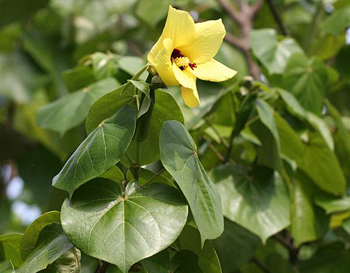
Hibiscus tea is rose-colored with lemony flavor. Served hot or iced. Delightful summer drink in its cold form.
Back to Top
How Sold
Commercial hibiscus teas are made either from the flowers or from the calyces of the flowers. Also available as a tincture.
Back to Top
Warning
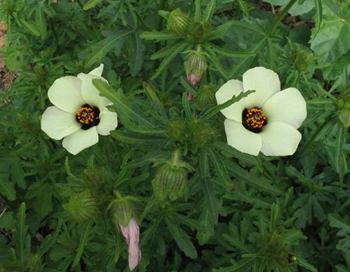
All potentially toxic. Degree of toxicity unknown.
Back to Top
Resource Links
Top 13 Teas to Reduce Bloating Naturally and Effectively
Real Simple – 13 Best Teas for Bloating, According to a Registered Herbalist
Back to Top
Bibliography
![]() The Herb Book
The Herb Book, by John Lust, Bantam Books, 666 Fifth Avenue, New York, NY. copyright 1974.
![]() Eastern/Central Medicinal Plants
Eastern/Central Medicinal Plants, by Steven Foster and James A. Duke., Houghton Mifflin Company, 215 Park Avenue South, New York, NY 10000
Herbal Gardening, compiled by The Robison York State Herb Garden, Cornell Plantations, Matthaei Botanical Gardens of the University of Michigan, University of California Botanical Garden, Berkeley., Pantheon Books, Knopf Publishing Group, New York, 1994, first edition
![]() Planetary Herbology
Planetary Herbology, by Michael Tierra, C.A., N.D., O.M.D., Lotus Press, PO Box 325, Twin Lakes. WI 53181., Copyright 1988, published 1992
 Taber’s Cyclopedic Medical Dictionary
Taber’s Cyclopedic Medical Dictionary, 15th Edition, F. A. Davis Company, 1915 Arch Street, Philadelphia, PA 19103
![]() Webster’s New World Dictionary
Webster’s New World Dictionary, Third College Edition, Victoria Neufeldt, Editor in Chief, New World Dictionaries: A Division of Simon & Schuster, Inc., 15 Columbus Circle, New York, NY 10023
![]() The Yoga of Herbs: An Ayurvedic Guide to Herbal Medicine
The Yoga of Herbs: An Ayurvedic Guide to Herbal Medicine, by Dr. David Frawley & Dr. Vasant Lad, Lotus Press, Twin Lakes, Wisconsin, Second edition, 1988.
 The Healing Plants
The Healing Plants, by Mannfried Pahlow, Barron’s Educational Series, Inc. 250 Wireless Blvd., Hauppauge, NY 11788, 1992
